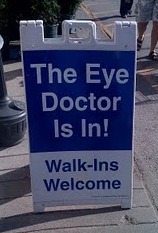June 27th, 2010 by Medgadget in Better Health Network, News, Research
2 Comments »

 Researchers at MIT have developed a method of using a basic cellphone coupled with a cheap and simple plastic device clipped onto the screen to estimate refractive errors and focal range of eyes.
Researchers at MIT have developed a method of using a basic cellphone coupled with a cheap and simple plastic device clipped onto the screen to estimate refractive errors and focal range of eyes.
Because of its simplicity, and the fact that soon just about everyone will have access to a mobile phone, eye exams may become available to the whole world at little to no cost. Read more »
*This blog post was originally published at Medgadget*
May 28th, 2010 by Happy Hospitalist in Better Health Network, Humor, Opinion, True Stories
2 Comments »

 I snapped this picture of “The Eye Doctor Is In!” sign at my local Sam’s Club. Who is this “eye doctor?” Are they a Dr. Nurse? Are they an optometrist? Are they a medical doctor? What is the difference between an optometrist and an ophthalmologist? The sign just says “eye doctor.” Who is it? Who knows. What are their credentials? Who knows.
I snapped this picture of “The Eye Doctor Is In!” sign at my local Sam’s Club. Who is this “eye doctor?” Are they a Dr. Nurse? Are they an optometrist? Are they a medical doctor? What is the difference between an optometrist and an ophthalmologist? The sign just says “eye doctor.” Who is it? Who knows. What are their credentials? Who knows.
To practice optometry, an optometrist must graduate from an accredited four-year post graduate institution after completing at least three years of undergraduate preoptometry course requirements and then get licensed in their state of practice.
To practice ophthalmology, an ophthalmologist must graduate from an accredited four-year medical school after completing the 90+ undergraduate premedical couurse requirements, then complete a residency in ophthalmology which consists of an internship year in internal medicine or general surgery and three years or more of additional training in ophthalmology. Then they must get licensed by state authorities.
The lay public — the really lay public — has no idea what the state and federal licensing standards are for the different professional clinical training tracks. Read more »
*This blog post was originally published at The Happy Hospitalist*
April 13th, 2010 by Medgadget in Better Health Network, Health Tips, News, Opinion, Research
No Comments »

 Researchers at the University of Florida in Gainesville have developed a vitamin E-secreting contact lens that can bring the valuable antioxidant directly to eyes.
Researchers at the University of Florida in Gainesville have developed a vitamin E-secreting contact lens that can bring the valuable antioxidant directly to eyes.
Vitamin E is packaged into clusters within the lens and the aggregate works to slowly release the chemical while remaining invisible to the eye.
“These vitamin structures are like ‘nanobricks’,” said Anuj Chauhan, Ph.D., lead researcher of the study. “The drug molecules can’t go through the vitamin E. They must go around it. Because the nanobricks are so much bigger than the drug molecules -– we believe about a few hundred times bigger –- the molecules get diverted and must travel a longer path. This increases the duration of the drug release from the lenses.” Read more »
*This blog post was originally published at Medgadget*
April 3rd, 2010 by DrCharles in Better Health Network, Humor, True Stories
No Comments »

 “Will you grab that spider web?” my grandmother said abruptly. We were sitting on an old bench overlooking the river. It was September. I had sprung her from the assisted living home earlier that day.
“Will you grab that spider web?” my grandmother said abruptly. We were sitting on an old bench overlooking the river. It was September. I had sprung her from the assisted living home earlier that day.
“Which spider web are you talking about, Gram?” I asked her. My eyes were sleepily watching the timeless flow of the big river, the eddies and swirls along the banks, and the gracefully bending boughs of the old oak trees as they waltzed with the wind.
“There to the left!” she said with certainty, reaching her bony hand into the sky and grasping at thin air. “Get it, will you?”
I looked again but there was nothing. I knew that my grandmother’s mind had developed a little static among the signals, a few crackling wires in the electric grid of her brain, and I figured that her eyes were playing tricks on her.
“I don’t see it, Gram. What does it look like?”
She seemed a little disappointed that I did not share her perception. “It’s feathery, and it’s drifting just over the river. It’s actually quite pretty.” Read more »
*This blog post was originally published at The Examining Room of Dr. Charles*
 Researchers at MIT have developed a method of using a basic cellphone coupled with a cheap and simple plastic device clipped onto the screen to estimate refractive errors and focal range of eyes.
Researchers at MIT have developed a method of using a basic cellphone coupled with a cheap and simple plastic device clipped onto the screen to estimate refractive errors and focal range of eyes.



 I snapped this picture of “The Eye Doctor Is In!” sign at my local Sam’s Club. Who is this “eye doctor?” Are they a
I snapped this picture of “The Eye Doctor Is In!” sign at my local Sam’s Club. Who is this “eye doctor?” Are they a  Researchers at the University of Florida in Gainesville have developed a vitamin E-secreting contact lens that can bring the valuable antioxidant directly to eyes.
Researchers at the University of Florida in Gainesville have developed a vitamin E-secreting contact lens that can bring the valuable antioxidant directly to eyes.









